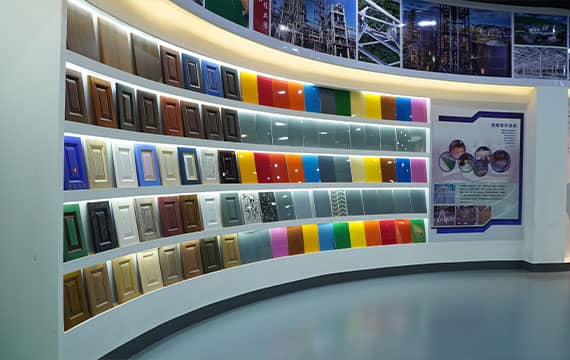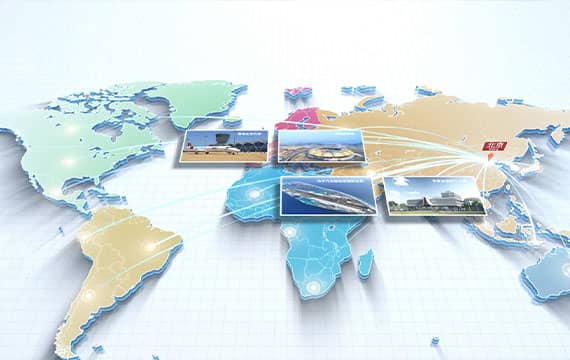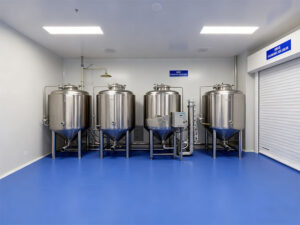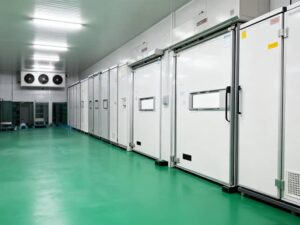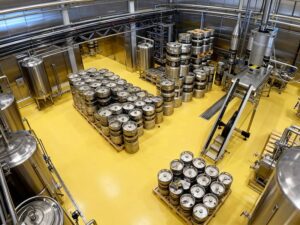
JINYU PAINT® Epoxy Floor Coating
Welcome to JINYU PAINT®, your trusted source for premium epoxy floor coatings. Whether you’re looking for a garage floor coating, basement epoxy coating, or industrial epoxy flooring, our products provide exceptional durability, resistance to wear, and a long-lasting finish for both residential and commercial applications.
Our epoxy floor coatings are designed to withstand the harshest conditions while providing an aesthetically pleasing and highly functional surface. From DIY kits to professional installation services, we offer a comprehensive range of products tailored to suit all your needs. Explore our catalog to find the perfect epoxy coating for your space.
JINYU PAINT® PRODUCTS
Showing 1–16 of 17 results
-

E156 Water-based Epoxy Primer
Read more -

E159X Epoxy Primer (Penetrating Type)
Read more -

E336 Water-based Epoxy Middle Coating
Read more -

E337 Epoxy Middle Coating
Read more -

E550 Solvent-based Epoxy Topcoat
Read more -

E552 Anti Static Self-leveling Epoxy Coating
Read more -

E556 Water-based Epoxy Finish
Read more -

E811 Solvent-free Epoxy Primer
Read more -

E811-2 Solvent-Free Epoxy Floor Primer Mid Coating
Read more -

E820 Epoxy Self-Leveling Intermediate Floor Coat
Read more -

E822 Solvent-free Intermediate Paint
Read more -

E8300 Self-leveling Epoxy Floor Top Coat
Read more -

E8302 Solvent-Free Self-Leveling Epoxy Floor Top Coat
Read more -

E8308 Epoxy Colored Sand Self-Leveling Topcoat
Read more -

E850 Epoxy Orange Peel Floor Finish
Read more -

E860 Spreadable Epoxy Top Coat
Read more
What is Epoxy Flooring?
Epoxy flooring (epoxy resin flooring) is a type of functional floor coating primarily composed of epoxy resin as the main film-forming material, combined with curing agents, thinners, solvents, dispersants, defoamers, and other additives. It incorporates fillers such as talcum powder and quartz sand, forming a durable surface through cross-linking reactions, applied via specialized construction techniques on-site. As a key category within resin-based flooring systems, similar products include polyurethane flooring, acrylic resin flooring, vinyl ester resin flooring, and polyurea flooring.
What Are the Types of Epoxy Flooring?
Epoxy flooring can be categorized into different types based on application scope, performance characteristics, and slight variations in construction techniques. Below is a detailed breakdown of 8 major types of epoxy flooring systems.
1. Solvent-Free Epoxy Self-Leveling Floor Coating Series
Appliction ideal for:
• GMP-certified pharmaceutical / blood product facilities
• Hospital sterile zones
• Electronics / microelectronics plants
• Data centers / airports
• Offices / gymnasiums / schools, etc.
Performance Features:
1. Ultra-high cleanliness, dustproof & load-bearing
2. Smooth, glossy finish with excellent self-leveling properties
3. Seamless surface, easy to clean, long-lasting aesthetics
4. Chemical-resistant (strong acids, alkalis, solvents)
5. Adjustable thickness (1-5mm)
6. Service life: 3-10 years
Construction Process:
1. Base preparation: Grinding, cleaning, ensuring dryness & flatness (no hollows)
2. Primer coat: Enhances adhesion & seals the substrate
3. Mid-coat: Sand/trowel application for leveling (adjustable thickness)
4. Mid-coat grinding & dust removal
5. Topcoat: Trowel-applied solvent-free epoxy self-leveling coating
2. Solvent-Free Epoxy Roller/Trowel Floor Coating Series
Ideal for coating solutions in:
• Schools & hospitals
• Electronics & power plants
• Food & pharmaceutical facilities
• Textile factories
• Underground parking garages
Performance Features:
1. Dustproof, moisture-resistant, wear-resistant, crack-free
2. Easy to clean, fast installation, low maintenance, cost-effective
3. Superior adhesion, flexibility, vibrant color options
4. Thickness: 0.3-1mm
5. Service life: 3-5 years
Construction Process:
1. Base preparation: Grinding & cleaning (dry, flat, no hollows)
2. Primer coat: Seals substrate & enhances adhesion
3. Mid-coat: Sand/trowel leveling (adjustable thickness)
4. Mid-coat grinding & dust removal
5. Solvent-free epoxy topcoat application
3. Anti-Static Epoxy Floor Coating Series
Applications:
• Aerospace facilities
• Computer server rooms
• Electronics manufacturing plants
• Military industrial facilities
• Dam control centers
• Flammable/explosive production areas
Performance Features:
1. High compressive strength & impact resistance with excellent toughness
2. Surface resistance 10⁵-10⁹Ω for permanent anti-static protection
3. Smooth textured finish with premium aesthetics
4. Easy to clean & stain-resistant
5. Thickness: 0.5-3mm (customizable)
6. Service life: 3-10 years
Construction Process:
1. Base preparation: Grinding & cleaning (dry, flat, no hollows)
2. Primer coating: Epoxy primer + anti-static primer for substrate sealing
3. Copper foil laying: Embedded conductive network
4. Anti-static mid-coat: Sand/trowel leveling for conductivity
5. Grinding & vacuuming: Surface refinement
6. Topcoat application: Anti-static epoxy finish (roller or self-leveling)
4. Epoxy Quartz Sand Flooring Series
Ideal for premium aesthetic spaces requiring clean, decorative floors:
• Tobacco factories
• Hotels & luxury resorts
• High-end entertainment venues
• Office towers & convention centers
Product Features:
1. Natural textured finish with authentic quartz aesthetics
2. Vibrant color options & customizable designs
3. Unlimited pattern combinations for bespoke flooring
4. High load-bearing capacity (industrial-grade durability)
5. Breathable coating with natural curing properties
6. Luxurious appearance elevating interior spaces
7. Thickness: 3-10mm (heavy-duty build)
8. Service life: 10+ years
Construction Process:
1. Base preparation: Grinding & cleaning (dry, flat, no hollows)
2. Primer coating: Specialty epoxy quartz sand primer for substrate sealing
3. Quartz sand application: Even spreading of colored quartz aggregates
4. Surface refinement: Excess sand removal + epoxy transparent putty leveling
5. Topcoat sealing: High-gloss epoxy clear coat for protection & shine
5. Epoxy Terrazzo Floor Coating Series
Designed for high-end commercial & industrial spaces:
• Tobacco factories
• Hotels & luxury resorts
• Premium entertainment venues
• Corporate towers & exhibition halls
• Hypermarkets
• Mega-scale industrial plants
Product Features:
1. Extreme compressive strength & impact resistance
2. Vibrant color palette with unlimited design potential
3. Fully customizable patterns & aggregates
4. Glossy refined surface with long-term durability
5. Premium aesthetic conveying prestige
6. Thickness: 5-10mm (heavy-duty construction)
7. Service life: 15+ years
Construction Process:
1. Base preparation: Grinding & cleaning (dry, flat, no hollows)
2. Primer coating: Epoxy substrate sealer
3. Putty leveling: Smooth underlayment application
4. Aggregate embedding: Colored stones/quartz mid-layer troweling
5. Grinding & polishing: Precision surface refinement
6. Clear topcoat: High-gloss epoxy protective finish
6. Anti-Slip Epoxy Floor Coating Series
Designed for high-traction environments:
• Industrial floors exposed to water/oil
• Premium residential/hotel parking garages
• Garage ramp slip-resistant surfaces
• Other high-friction flooring requirements
Product Features:
1. High compressive strength & impact resistance
2. Smooth yet textured surface finish
3. Adjustable slip-resistance levels (moderate to high)
4. Easy-to-clean & stain-resistant
5. Thickness: 0.5-5mm (customizable)
6. Service life: 3-10 years
Construction Process:
1. Base preparation: Grinding & cleaning (dry, flat, no hollows)
2. Primer coating: Epoxy substrate sealer for enhanced adhesion
3. Mid-coat application: Sand/putty leveling (thickness-adjusted)
4. Surface refinement: Grinding & vacuuming
5. Topcoat options:
• Orange-peel texture epoxy coating
• Grit-embedded anti-slip finish
7. Water-Based Epoxy Floor Coating Series
Designed for eco-sensitive environments:
• Food processing plants
• Schools & hospitals
• Precision manufacturing
• Biopharmaceutical facilities
• Instrumentation labs
Product Features:
1. Eco-friendly & non-toxic (Zero/low VOC)
2. Matte/satin finish with natural aesthetics
3. Glare-free surface (no light pollution)
4. Superior adhesion & coverage
5. Breathable coating allowing substrate moisture regulation
6. Thickness: 0.5-3mm
7. Service life: 3-10 years
Construction Process:
1. Base preparation: Grinding & cleaning (dry, flat, no hollows)
2. Primer coating: Water-based epoxy sealer for substrate bonding
3. Mid-coat application: Sand/putty leveling (thickness-adjusted)
4. Surface refinement: Grinding & vacuuming
5. Topcoat options:
• Water-based epoxy roller coat
• Self-leveling water-based epoxy
8. Epoxy-Polyurethane Hybrid Floor Coating Series
General industrial & commercial spaces:
• Food processing plants
• Chemical plants
• Offices & warehouses
• Kitchens & cafeterias
• Retail stores
• Schools & hospitals
• Staircases & corridors
• Indoor parking garages
Product Features:
1. Exceptional chemical & oil resistance
2. Brilliant color retention & easy cleaning
3. Cost-effective & easy installation
4. High abrasion resistance (medium load-bearing)
5. Thickness: 0.5-3mm
6. Service life: 5+ years
Construction Process:
1. Substrate preparation: Grinding & cleaning (dry, flat, no hollows)
2. Primer application: Polyurethane Component A base coat
3. Putty leveling: Polyurethane filler application
4. Topcoat application: Two coats of Polyurethane Component A
5. Clear coat finish: Single coat of polyurethane sealer
Basic Classification of Epoxy Floor Coatings
Epoxy floor coatings can be categorized based on dispersion medium into:
- Solvent-based epoxy flooring
- Solvent-free epoxy flooring
- Water-based epoxy flooring
Based on coating structure, they are classified as:
- Epoxy floor primer
- Epoxy intermediate coat
- Epoxy topcoat
- Epoxy clear coat
From a functional perspective, main types include:
- Abrasion-resistant epoxy flooring
- Anti-static epoxy flooring
- High-temperature & fire-resistant epoxy flooring
- Antimicrobial epoxy flooring
- Chemical-resistant epoxy flooring
The market-dominant epoxy floor coatings currently are:
- Thin-film solvent-based epoxy coatings
- Solvent-free self-leveling epoxy abrasion-resistant flooring
- Acid-resistant self-leveling epoxy coatings
- Conductive self-leveling epoxy flooring
Advantages & Disadvantages of Epoxy Resinous Flooring Coatings
Epoxy flooring is a high-quality decorative and functional coating system that provides excellent aesthetics, durability, and performance. It forms a strong, seamless film with vibrant colors and a smooth, easy-to-clean surface, making it suitable for various industrial, commercial, and residential applications.
Advantages of Epoxy Floor Coatings
- Seamless and dustproof surface
Meets cleanliness requirements for high-standard industrial plants - Customizable colors with excellent aesthetics
- Waterproof, mold-resistant and impermeable
- Wear-resistant and pressure-bearing
Can withstand heavy vehicles with certain flexibility to prevent delamination or cracking under minor impacts - Strong adhesion to substrates (concrete, tiles, metal, etc.)
- Resistant to moderate chemical corrosion
 Disadvantages of Epoxy Floor Coatings
Disadvantages of Epoxy Floor Coatings
- Poor resistance to ground moisture
The dense molecular structure prevents moisture penetration. Without proper moisture barrier on ground-level concrete, vapor pressure may cause blistering and subsequent coating failure.
- Low scratch resistance
Vulnerable to scratches from sharp objects like sand or metal chips. Requires frequent cleaning in workshops.
- Poor heat resistance
Maximum tolerance around 80°C. In high-traffic areas, sudden braking may generate temporary high temperatures causing softening, while tire dust may penetrate and discolor the coating.
- Poor weather resistance
Weak UV resistance makes it unsuitable for outdoor use, as it accelerates aging, causing discoloration, strength reduction, chalking and delamination.
Applications of Epoxy Resin Flooring Systems
- Industrial facilities (warehouses, manufacturing plants)
- Commercial spaces (retail stores, showrooms)
- Public institutions (hospitals, schools, laboratories)
Industrial Flooring Applications
- Heavy-duty epoxy floor coatings for production lines
- Abrasion-resistant epoxy floors for high-traffic areas
- High-performance epoxy coatings for forklift traffic
- Slip-resistant epoxy floors for loading docks
- Oil-resistant epoxy floor systems
- Chemical-proof epoxy coatings for service bays
- FDA-compliant epoxy flooring
- Sanitary epoxy floor systems with seamless surfaces
- Cleanroom epoxy flooring meeting GMP standards
- Acid-resistant epoxy coatings
- Static-dissipative epoxy floors for sensitive equipment
- Heavy-duty epoxy coatings for hangars
- ESD epoxy flooring for static control
- Anti-contamination epoxy floors
- Thermal-shock resistant epoxy
- Low-temperature epoxy floor systems
- High-temperature epoxy coatings
- Chemical-resistant epoxy floors for utility areas
- Ultra-wear-resistant epoxy floors
- Impact-resistant epoxy coatings
Commercial Flooring Applications
- Decorative epoxy floors with custom designs
- High-gloss epoxy finishes for visual appeal
- Polished epoxy floors for modern interiors
- Low-VOC epoxy coatings for indoor air quality
- Luxury epoxy flooring for lobbies
- Stain-resistant epoxy floors for restaurants
- Grease-resistant epoxy coatings
- Easy-clean epoxy floor systems
- Antimicrobial epoxy flooring
- Seamless epoxy floors for hygiene
- Slip-resistant epoxy coatings
- Shock-absorbent epoxy floors
- Durable epoxy floors for classrooms
- Low-maintenance epoxy coatings
- High-traffic epoxy flooring
- Chemical-resistant epoxy systems
- Decorative epoxy floors for event spaces
- Scratch-resistant epoxy coatings
- Epoxy garage floors
- Decorative epoxy coatings for lobbies
Environmental Requirements for Epoxy Floor Coating Installation (Temperature, Humidity, Substrate Moisture, etc.)
Epoxy floor coatings are high-value, high-performance products with stringent application requirements. Below are the detailed environmental specifications for epoxy floor paint installation:
1. Hardness
Hardness refers to the compressive strength of the substrate or the concrete grade. The substrate hardness fundamentally determines the epoxy floor coating lifespan, adhesion strength, and overall performance.
2. Temperature
Temperature indicates the ambient conditions during epoxy floor paint application. Different types of epoxy coatings have varying temperature tolerances. Standard epoxy floor systems require installation between 5°C–30°C (41°F–86°F).
3. Flatness
Flatness measures the levelness of the substrate. The substrate’s flatness directly impacts the smoothness of the epoxy floor coating, which affects aesthetics and functionality (e.g., self-leveling epoxy floors).
4. Roughness
Roughness describes the microscopic peaks and valleys on the substrate surface. The ideal epoxy floor coating substrate should have a wave distance (peak-to-peak) below 1mm. Smoother surfaces reduce epoxy coating adhesion, while slightly textured surfaces enhance bonding.
5. Thickness
Thickness refers to the top concrete layer (not the entire base). Insufficient thickness (<5cm or <2 inches) may cause epoxy floor delamination or bubbling. The substrate must meet C25 concrete hardness standards.
6. Ventilation
Ventilation is critical for two-part epoxy floor coatings because curing releases heat and moisture. The workspace should be moderately ventilated—excessive airflow can cause uneven curing.
7. Humidity
Humidity includes both substrate moisture content and ambient air humidity. For epoxy floor paint:
- Substrate moisture: ≤8% (measured via ASTM D4263). Higher levels cause epoxy floor bubbles or peeling.
- Air humidity: 30%–85% (measured with a hygrometer). Extreme humidity compromises curing.
8. Cleanliness
The substrate must be dust-free, with no loose cement particles, to ensure optimal epoxy floor coating aesthetics and durability.
Epoxy Floor Maintenance and Care Guide
Maintenance
Avoid Mechanical Abuse
Do not use excessive force or heavy impacts on the epoxy floor coating. Avoid striking the surface with extremely heavy or hard objects unless necessary. Minimize unnecessary grinding to preserve the epoxy floor finish.
Surface Cleaning
Cleaning an epoxy floor paint surface is simple—usually requiring just water and wiping. For stubborn stains, use a mild detergent, industrial degreaser, or cleaner, followed by rinsing with water. For extremely tough stains, mechanical cleaning can be used, but avoid excessive pressure or abrasion to prevent damage to the epoxy floor’s smoothness and gloss.
Repairing Wear & Damage
If the epoxy floor shows signs of wear, scratches, or minor damage over time, small areas can be spot-repaired. For larger damaged sections, a full recoat is recommended. If there are major coating defects, report them immediately to prevent oil or contaminants from penetrating the substrate. When washing the floor, avoid letting oil-water mixtures accumulate in deep cracks. Wipe spills immediately with a dry cloth.
Preventing Abrasive Damage
Remove coarse particles, sand, or mud promptly to prevent grinding damage to the epoxy floor surface. When using tools, ensure they do not fall and scratch the floor. For hard objects (e.g., metal chairs, tables, or racks), wrap their legs with soft plastic, rubber, or place cardboard underneath to prevent scratches on the epoxy floor coating.
Avoid Chemical Contamination
Prevent exposure to harsh chemicals that may degrade the epoxy floor paint.
Oil Stain Prevention
Use sawdust to clean oil-stained areas regularly, preventing oil from hardening and attracting dust (which can become stubborn stains). For large oil spills, use a wide mop with sawdust to absorb the oil effectively.
Care
Floor Cleaning
First, clean the epoxy floor with a scrubber and a neutral detergent. Then, use a wet vacuum to remove dirty water and allow the floor to dry before proceeding.
Wax Application
Apply epoxy floor wax in a figure-eight (“∞”) pattern using a wax mop. Ensure even wax distribution with each dip. For large epoxy flooring areas, multiple workers can work side by side while wearing shoe covers. After the first wax layer dries, apply a second coat if needed.
Polishing
Once the wax is fully dry, use a floor polisher with a buffing pad to enhance the epoxy floor’s shine and durability.
Types of Epoxy Floor Coating We Offer:
- Epoxy Floor Coating for Garage: Achieve a smooth, durable finish for your garage floors. Epoxy floor coating for garage ensures a stain-resistant, long-lasting surface.
- Epoxy Floor Coating for Basement: Protect your basement floor from moisture and damage with our reliable, waterproof epoxy coatings.
- Industrial Epoxy Floor Coatings: Our industrial epoxy floor coatings provide superior protection against heavy foot traffic and machinery, making them perfect for factories, warehouses, and other high-traffic areas.
- Epoxy Floor Coating Over Tile and Wood: Our products can be applied over existing tile or wood, providing a new look and long-term protection.
- Custom Epoxy Floor Coating Systems: For more specific needs, we offer customizable epoxy floor coating systems tailored to your requirements.
FAQS of Epoxy Floor Coating
1. What is the best epoxy floor coating for concrete?
A1: We offer a range of epoxy floor coatings for concrete that are specifically formulated to provide a durable, long-lasting finish that resists stains, chemicals, and moisture.
2. Can epoxy floor coating be applied over tile or wood?
A2: Yes, you can apply epoxy floor coating over tile or wood, but it requires surface preparation, including sanding or priming, to ensure strong adhesion.
3.How long does epoxy floor coating last?
A3: When applied correctly, epoxy floor coating can last between 10 to 20 years in residential settings and up to 10 years in high-traffic commercial areas.
4. How much does epoxy floor coating cost?
A4: The cost varies depending on your project’s size and requirements. Typically, epoxy floor coating price ranges from $2 to $12 per square foot.
5. Where can I find epoxy floor coating near me?
A5: We work with local distributors and installers to bring you the best epoxy floor coating services. Use our online store locator or contact us directly to find an installer near you.
6. Is epoxy floor coating a DIY project?
A6: Yes, with the right tools and our easy-to-follow instructions, DIY epoxy floor coating is a great option for homeowners. For larger areas or professional results, we recommend using epoxy floor coating contractors.
7.Epoxy Floor Thickness
A7: The thickness of epoxy floor coatings varies from 0.5mm to 5mm, depending on the type. For industrial epoxy flooring, thickness design must consider factors like flatness requirements, load-bearing capacity, and service life.
8.Is Epoxy Floor Oil-Resistant?
A8: Yes, epoxy floor paint provides resistance against common oils (e.g., engine oil, gear oil) and prevents penetration.
9.Is Epoxy Floor Acid & Alkali Resistant?
A9: It withstands mild acids and alkalis for short durations. For highly corrosive environments (e.g., 98% sulfuric acid), specialized epoxy anti-corrosion flooring is recommended—it remains color-stable and non-penetrable.
10.Can Epoxy Floor Be Used Outdoors?
A10:Generally not recommended. For outdoor applications:
Use standard epoxy primer & mid-coat
Top with weather-resistant polyurethane flooring or ceramic particle-based epoxy coatings
11.Is Epoxy Floor Toxic?
A11:Raw epoxy resin contains trace volatile compounds, but once fully cured (after the hardening period), it becomes non-toxic and safe for human contact.
12.Epoxy Floor Safety Requirements
A12:Oily/sloped areas: Use anti-slip epoxy flooring
Gas stations/oil depots: Requires anti-static & explosion-proof epoxy coatings
13.Epoxy Floor Safety Requirements
A13:Typical service life: 5–8 years under normal conditions.
14.Substrate Requirements for Epoxy Flooring
A14:a. Compressive strength: ≥20MPa
b. Self-leveling treatment before application
c. Moisture content: <8%
d. Flatness compliance: Meets national standards
15.Can Epoxy Floor Be Applied Over Terrazzo?
A15:a. Compressive strength: ≥20MPa
b. Self-leveling treatment before application
c. Moisture content: <8%
d. Flatness compliance: Meets national standards
16.Epoxy Floor Initial Curing Time
A16:Summer: 10–12 hours
Winter: 12–24 hours
17.Noise Reduction in Epoxy Garage Floors
A17:For underground parking, use:
- Epoxy orange-peel textured anti-slip flooring
- Grit-enhanced anti-slip epoxy coatings
18.Can Epoxy Floor Scratches Be Repaired?
A18:Yes. For severe damage: Spot-repair with fresh epoxy topcoat; Apply a protective gloss overcoat
19.Is Epoxy Floor Suitable for Food Industry?
A19:Yes. Food-grade epoxy flooring (e.g., water-based epoxy paint) meets hygiene standards.
20.Epoxy Floor Acceptance Criteria
A20: a. Full cure at 25°C: 2–3 days (80% hardness achieved)
b. No sticky surface
c. Bubbles:Standard/sand epoxy: Zero bubbles; Self-leveling epoxy: ≤1 bubble/10m²
d. Smooth finish: No trowel marks, seamless transitions
e. Color consistency: Minimal batch-to-batch variation
f. Minor defects: Only dust-related micro-imperfections allowed
g. Gloss levels:High-gloss: ≥90°; Gloss: ≥70°; Semi-gloss: 50–70° (water-based epoxy: semi-gloss to matte)
h. Texture: Pronounced orange-peel/anti-slip effects
21.Can Epoxy Floor Be Used in Cold Storage?
A21: Not recommended. Use specialized cold-storage floor paint.
22.Causes of Epoxy Floor Pinholes (Fish Eyes)
A22: Poor substrate sealing; Improper material mixing; Rapid curing; Excessive additives
23.Epoxy Floor Refurbishment Cycle
A23: 5–8 years before recoating or full restoration is needed.
24.Why Does Self-Leveling Epoxy Show Trowel Marks?
A24: Fast curing → Poor flow; Inadequate defoaming; Uneven troweling
25.Solving Epoxy Floor Bubble Issues During Installation
A25: Pre-test moisture with a concrete moisture meter; Waterproofing for high-moisture substrates; Use hydrophilic epoxy primer
25.Epoxy Floor Color Inconsistency Causes
A25: Inadequate resin mixing; Delayed seam overlapping; Uneven coating thickness; Work interruptions; Mixed paint batches;
26.Does Epoxy Floor Need Expansion Joints?
A26: Depends on floor area and substrate joint design.
27.Why Does Epoxy Floor Delaminate?
A27: Insufficient substrate prep; Missing waterproof membrane; Overloading beyond design limits
28.Epoxy Floor Usage Precautions
A28: a. 7–10 day curing period before use; b. Avoid water/solution exposure during curing; c. Wear soft-soled shoes; d. Pad metal furniture legs; e. Clean with absorbent mops (avoid wet slips); f. Protect floors with cardboard during equipment moves
29.Types of Epoxy Curing Agents
A29: Polythiols; Aliphatic polyamines; Aromatic; polyamines; Polyamides; Anhydrides
30.Types of Epoxy Curing Agents
A30: Yes, but minimum 5°C surface temperature required for winter application.
31.Common Epoxy Thinners
A31: Ethyl acetate; Butyl acetate; Methyl ethyl ketone (MEK); Cyclohexanone; Butyl glycidyl ether
32.Fixing Epoxy Floor Color Variation
A32: Premix resin thoroughly; Continuous application (avoid seam delays); Skilled labor + proper tools; Batch consistency (no mid-job material changes)
33.Why Does Epoxy Paint Bleed Water?
A33: Uncured primer
Primer/topcoat color mismatch; Pigmented substrate contamination; Organic pigments in primer
34.Why Does Epoxy Paint Bleed Water?
A34: Mainly improper application or degraded paint components.
35.Epoxy Defects: Pitting, Orange Peel, Discoloration, Lifting
A35: Pitting: Localized shrinkage craters (0.5–3mm); Orange peel: Solvent evaporation-induced texture
; Discoloration: Color shifts during storage/use; Lifting: Topcoat dissolves uncured base layers
36.Epoxy Floor Installation Process
- A36: Surface preparation
- Epoxy primer application
- Putty filling
- Sanding & vacuuming
- Basecoat (epoxy resin + hardener, 10-min induction)
- Crack repair (epoxy + quartz sand)
- Mid-coat troweling
- Topcoat application
- Curing (7–10 days)
37.Epoxy Floor Installation Process
A37: Initial stage: Loss of gloss; Progression: Color fading; Advanced: Chalking (powdery surface)
38.Restoring Faded/Discolored Epoxy Floors
A38: Reapply epoxy topcoat to revive aesthetics.
39.Restoring Faded/Discolored Epoxy Floors
A39: Requires complete stripping & reinstallation.
How Featured JINYU Paints Are Made?




JINYU® boasts a wide range of color options and customization possibilities. Color experts work closely with customers to create unique shades and finishes to suit their specific projects.


The Applications of Featured JINYU PAINT®
JINYU PAINT® provides a comprehensive range of high-performance coatings, including epoxy floor coatings, industrial coatings, fireproof coatings, and architectural coatings for interior and exterior walls. Our solutions are designed for durability, aesthetics, and protection across various applications, from residential and commercial buildings to industrial facilities and fire safety projects. Whether you need seamless flooring, corrosion resistance, fire protection, or decorative wall finishes, JINYU PAINT® offers expert coatings to enhance and protect every surface.










FAQ
- What is the ideal polyurethane floor solution for an automotive service bay
- How does polyurethane flooring perform in chemical plants?
- What flooring is recommended for high-temperature kitchens and bakeries?
- How to Choose PU Flooring for Pharmaceutical Manufacturing: A 5-Step Expert Guide
- What PU floor thickness is ideal for cold storage and freezers?
Contact Us
Contact: Ms. Sabella Wei
Phone: 86-022-83859963
Whatsapp: 15822925523














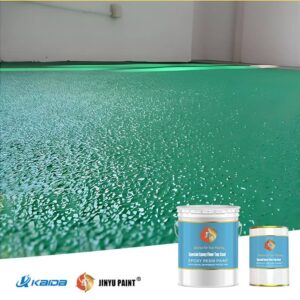
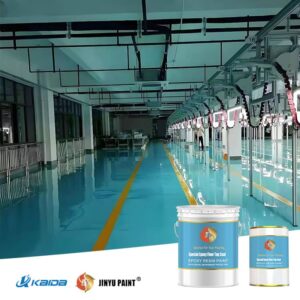
 Disadvantages of Epoxy Floor Coatings
Disadvantages of Epoxy Floor Coatings